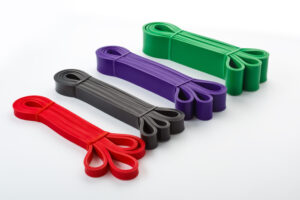Covid-19 closures around the world heavily impacted the daily workout routine of the layperson. When someone is used to going to the same gym on the same days each week to exercise, it can feel as though the world has been turned upside down when that routine is taken away. After fitness centers closed, people flocked to sporting goods stores and online retailers, draining their supply of dumbbells, barbells, kettlebells, benches, pull-up bars, and pretty much any traditional gym accessory. There were some that were fortunate enough to already have home gyms set up in their houses. Others resorted to performing playground pullups and living room split squats. But another segment of the population gravitated toward resistance bands, and even now with gyms open and retailers restocked, many of them have elected to stick with their newfound resistance workouts.

Resistance bands are not a new product. They have been around for decades and have been used heavily in the physical therapy / rehabilitation world. They have also garnered some significant exposure in recent years amongst elite professional athletes—according to TB12, Tom Brady’s fitness brand, the G.O.A.T. preaches the use of bands exclusively for resistance training. Many traditional weightlifting movements can be performed with bands without incurring the wear or tear associated with pumping iron. Recently, Sylvester Stallone–one of the driving forces behind the U.S. fitness revolution decades ago–has endorsed resistance band usage over free weights for injury prevention.

There are a few different styles to choose from (resistance tubes with handles, loop bands, or mini-bands), but all accomplish pretty much the same thing—they apply constant tension throughout a movement. When lifting weights, tension is only applied at the bottom of each movement (the initial lift), leaving the top of the movement significantly less strenuous. Bands, on the other hand, apply more resistance the further they are stretched from their source, and therefore, muscles are put under increasing tension as the move progresses. You learned from an earlier post of ours that you should focus on achieving 40 to 45 seconds of Time Under Tension (TUT) when training with resistance. Using bands ensures that tension is maintained consistently throughout each movement without any of the gaps that come with using weights.

Aside from the versatility and ease of use on joints, bands are also extremely portable, affordable, and take up little to no space. Below is a favorite band workout of ours that you can keep in your arsenal for when you’re on the road, pressed for time, or in need of a routine mix-up.

Each movement in this workout has an alternative option that you can use as well in case one is more challenging than the other. Or in the event you want to alternate moves for different days.
Band sequence: (15 seconds rest between sets)
Glute Bridge / Deadlift – 4×12
Squat / Split Squat (each side) – 4×12
Chest Press / Band Crossover (each side) – 4×15
Anchored Row / Seated Row – 4×15
Standing Overhead Press / Single Arm Overhead Press (each side) – 4×15
Standing Supination Curls / Alternating Reverse Curls (each side) – 4×15
Overhead Tricep Extensions / Tricep Kickbacks (each side) – 4×15
Face Pulls / Band Pullaparts – 3×12

We are in no way saying that weight training should be abandoned…it unquestionably has its benefits and is still the fastest way to achieve major strength gains. But that said, if you travel frequently, don’t live near a gym, or don’t have space at home for a bench or rack, then bands are a great alternative to maintain a consistent routine. They are more affordable than weights and are easier on the joints as well, thus leading to fewer injuries from training. At Captyn, we preach more well-rounded fitness regimens where balance, injury prevention, and consistency are key. That said, an exercise routine that blends bands, weights and cardio is ideal.



